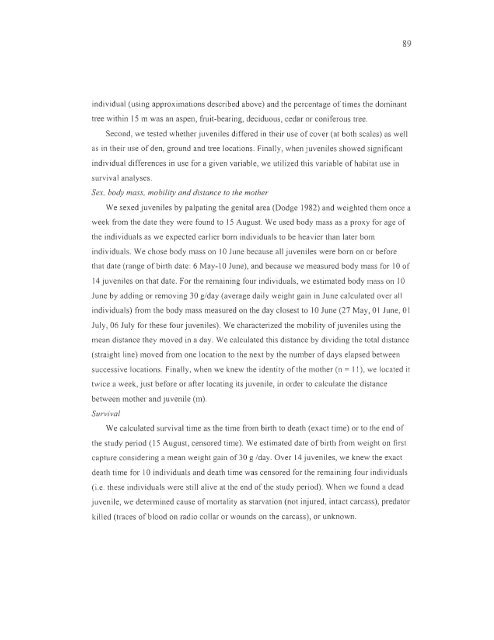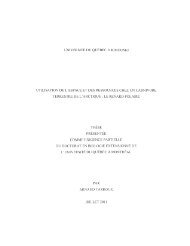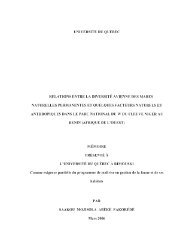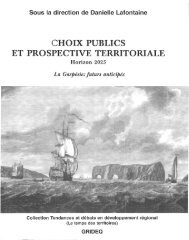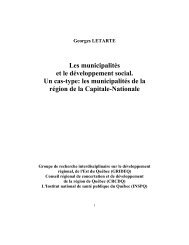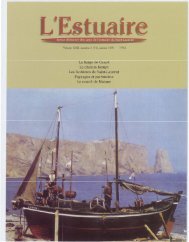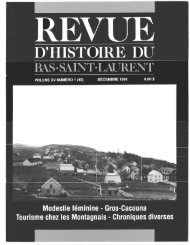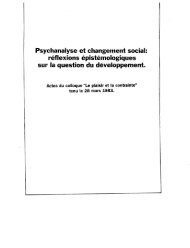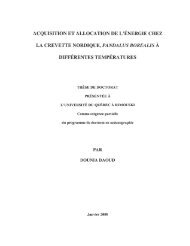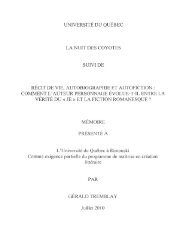influence du climat et de la prédation sur l'utilisation de l'habitat et la ...
influence du climat et de la prédation sur l'utilisation de l'habitat et la ...
influence du climat et de la prédation sur l'utilisation de l'habitat et la ...
Create successful ePaper yourself
Turn your PDF publications into a flip-book with our unique Google optimized e-Paper software.
89<br />
indivi<strong>du</strong>al (using approximations <strong>de</strong>scribed above) and the percentage of times the dominant<br />
tree within 15 m was an aspen, fruit-bearing, <strong>de</strong>ci<strong>du</strong>ous, cedar or coni ferous tree.<br />
Second, we tested wh<strong>et</strong>her juveniles differed in their use of coyer (at both scales) as weil<br />
as in th eir use of <strong>de</strong>n, ground and tree locations. F inally, when j uveniles showed significant<br />
indivi<strong>du</strong>al di fferences in use for a given variable, we utilized this variable of habi tat use in<br />
<strong>sur</strong>vival analyses.<br />
Sex, body mass, mobility and distance ta the mother<br />
We sexedjuveniles by palpating the genital area (Dodge 1982) and weighted them once a<br />
week from the date they were found to 15 August. We used body mass as a proxy fo r age of<br />
the indi vi<strong>du</strong>als as we expected earli er born indivi<strong>du</strong>als to be heavier than <strong>la</strong>ter born<br />
indi vi<strong>du</strong>als. We chose body mass on 10 June because ail j uveniles were born on or before<br />
that date (range of birth date : 6 May-I 0 June), and because we mea<strong>sur</strong>ed body mass fo r 10 of<br />
14 j uveniles on that date. For the remaining four indivi<strong>du</strong>als, we estimated body mass on 10<br />
June by adding or removing 30 g/day (average dail y weight gain in June calcu<strong>la</strong>ted over ail<br />
indivi<strong>du</strong>als) from the body mass mea<strong>sur</strong>ed on the day closest to 10 June (27 May, 01 June, 0 1<br />
July, 06 July for these four juveniles). We characterized the mobility ofjuveniles using the<br />
mean di stance the y moved in a day. We calcul ated thi s distance by di viding the total di stance<br />
(straight line) moved from one locati on to the next by the number of days e<strong>la</strong>psed b<strong>et</strong>ween<br />
successive locations. Finall y, when we kn ew the i<strong>de</strong>ntity of the mother (n = Il ), we located it<br />
twice a week, just before or after locating its juvenile, in or<strong>de</strong>r to calcu<strong>la</strong>te the di stance<br />
b<strong>et</strong>ween mother and juvenile (m).<br />
Survival<br />
We calcu<strong>la</strong>ted <strong>sur</strong>vival time as the time from birth to <strong>de</strong>ath (exact time) or to the end of<br />
the study period (1 5 August, censored time). We estimated date ofbirth from weight on first<br />
capture consi<strong>de</strong>ring a mean weight gain of30 g /day. Over 14 juvenil es, we knew the exact<br />
<strong>de</strong>ath time fo r 10 indi vi<strong>du</strong>als and <strong>de</strong>ath time was censored fo r the remaining fo ur indi vi<strong>du</strong>als<br />
(i .e. these indi vi<strong>du</strong>als were still ali ve at the end of the study peri od). W hen we fo und a <strong>de</strong>ad<br />
j uvenile, we d<strong>et</strong>ermined cause of mortality as starvation (not injured, intact carcass), predator<br />
killed (traces of blood on radio co l<strong>la</strong>r or wounds on the carcass), or unknown.


